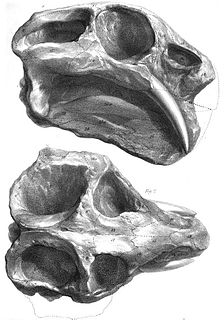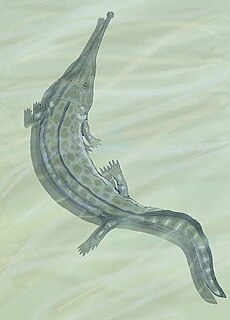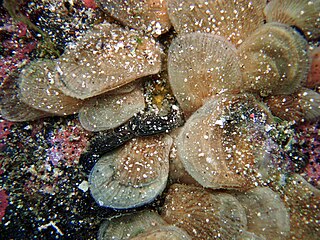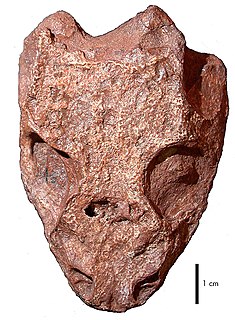
Bivalvia, in previous centuries referred to as the Lamellibranchiata and Pelecypoda, is a class of marine and freshwater molluscs that have laterally compressed bodies enclosed by a shell consisting of two hinged parts. Bivalves as a group have no head and they lack some usual molluscan organs like the radula and the odontophore. They include the clams, oysters, cockles, mussels, scallops, and numerous other families that live in saltwater, as well as a number of families that live in freshwater. The majority are filter feeders. The gills have evolved into ctenidia, specialised organs for feeding and breathing. Most bivalves bury themselves in sediment where they are relatively safe from predation. Others lie on the sea floor or attach themselves to rocks or other hard surfaces. Some bivalves, such as the scallops and file shells, can swim. The shipworms bore into wood, clay, or stone and live inside these substances.
The Guadalupian is the second and middle series/epoch of the Permian. The Guadalupian was preceded by the Cisuralian and followed by the Lopingian. It is named after the Guadalupe Mountains of New Mexico and date between 272.3 ± 0.5 – 259.8 ± 0.4 Mya. The series saw the rise of the therapsids, a minor extinction event called Olson’s Extinction and a significant mass extinction called the end-Capitanian extinction event.

The Rostroconchia is a class of extinct molluscs dating from the early Cambrian to the Late Permian. They were initially thought to be bivalves, but were later given their own class. They have a single shell in their larval stage, and the adult typically has a single, pseudo-bivalved shell enclosing the mantle and muscular foot. The anterior part of the shell probably pointed downward and had a gap from which the foot could probably emerge. Rostroconchs probably lived a sedentary semi-infaunal lifestyle. There were probably more than 1,000 species of members of this class.
In the geologic timescale, the Capitanian is an age or stage of the Permian. It is also the uppermost or latest of three subdivisions of the Guadalupian Epoch or Series. The Capitanian lasted between 265.1 and 259.1 million years ago. It was preceded by the Wordian and followed by the Wuchiapingian.

The Early Triassic is the first of three epochs of the Triassic Period of the geologic timescale. It spans the time between 251.902 Ma and 247.2 Ma. Rocks from this epoch are collectively known as the Lower Triassic series, which is a unit in chronostratigraphy.

Dicynodon is a genus of dicynodont therapsid that flourished during the Upper Permian period. Like all dicynodonts, it was herbivorous. This animal was toothless, except for prominent tusks, hence the name. It probably cropped vegetation with a horny beak, much like a tortoise, while the tusks may have been used for digging up roots and tubers.

Prionosuchus is an extinct genus of large temnospondyl. A single species, P. plummeri, is recognized from the early Permian period. Its fossils have been found in what is now northeastern Brazil.

Campylocephalus is a genus of eurypterid, a group of extinct aquatic arthropods. Fossils of Campylocephalus have been discovered in deposits ranging from the Carboniferous period in the Czech Republic to the Permian period of Russia. The generic name is composed of the Greek words καμπύλος (kampýlos), meaning "curved", and κεφαλή (kephalē), meaning "head".

Oxytoma is an extinct genus of bivalve molluscs that lived from the Late Permian to the early Paleocene, with a worldwide distribution except Australia. The genus was named in 1864 by Fielding Bradford Meek.

Brachiopods, phylum Brachiopoda, are a group of lophotrochozoan animals that have hard "valves" (shells) on the upper and lower surfaces, unlike the left and right arrangement in bivalve molluscs. Brachiopod valves are hinged at the rear end, while the front can be opened for feeding or closed for protection. Two major groups are recognized, articulate and inarticulate. The word "articulate" is used to describe the tooth-and-groove features of the valve-hinge which is present in the articulate group, and absent from the inarticulate group. This is the leading diagnostic feature (fossilizable), by which the two main groups can be readily distinguished. Articulate brachiopods have toothed hinges and simple opening and closing muscles, while inarticulate brachiopods have untoothed hinges and a more complex system of muscles used to keep the two valves aligned. In a typical brachiopod a stalk-like pedicle projects from an opening in one of the valves near the hinges, known as the pedicle valve, keeping the animal anchored to the seabed but clear of silt that would obstruct the opening.

Isognomon is a genus of marine bivalve mollusks which is related to the pearl oysters.

Claraia is an extinct genus of scallop-like bivalve molluscs that lived from the Capitanian stage of the Late Permian to the Anisian stage of the Middle Triassic, 266-237 million years ago. Fossils have been found worldwide in North America, Europe, Asia, Africa, and Australia. These are common fossils subsequent to the Permian-Triassic boundary, suggesting that the genus experienced rapid diversification during and after the Permian–Triassic extinction event, around 251.4 million years ago.

Broiliellus is an extinct genus of dissorophoid temnospondyl within the family Dissorophidae. Broiliellus is most closely related to the genus Dissorophus, and both have been placed in the subfamily Dissorophinae. Broiliellus is known from five species from the Early Permian: the type species is Broiliellus texensis, and the other species are Broiliellus brevis,Broiliellus olsoni, Broiliellus arroyoensis, and Broiliellus reiszi. An additional species, Broiliellus novomexicanus, which was originally named Aspidosaurus novomexicanus, is now thought to fall outside the genus as a member of the subfamily Eucacopinae.

Conjunctio is an extinct genus of dissorophid temnospondyl amphibian from the early Permian of New Mexico. The type species, Conjunctio multidens, was named by paleontologist Robert L. Carroll in 1964.

Acrolepis is an extinct genus of prehistoric bony fish that lived from the Tournaisian stage of the Mississippian to the late Permian epoch. Some species from the Early Triassic of Tasmania are also ascribed to Acrolepis.

Megalodon is an extinct genus of bivalve molluscs that reportedly lived from the Devonian to the Jurassic period. It is not clear, however, that all the fossils assigned to Megalodon from that span of time really belong in the same genus. Jurassic relatives of Megalodon such as Pachyrisma grande were closely related to the rudists.

Rubeostratilia is an extinct genus of amphibamiform temnospondyl from the early Permian of Texas. It is known from a single skull. This genus was named by Hélène Bourget and Jason S. Anderson in 2011, and the type species is Rubeostratilia texensis. The genus name comes from the Latin translation of 'redbeds' in reference to the Texas redbeds that produced both the holotype and many other early Permian fossils. The species name is for the state of Texas. The holotype and only known specimen was collected in 1941 from the Nocona Formation exposures in Clay County by a Works Projects Administration project that was transferred to the Field Museum of Natural History through an interinstitutional exchange with the Texas Memorial Museum.
Georgenthalia is an extinct genus of dissorophoid temnospondyl from the Lower Permian. It is an amphibamid which lived in what is now the Thuringian Forest of central Germany. It is known from the holotype MNG 11135, a small, complete skull. It was found in the Bromacker locality of the Tambach Formation. It was first named by Jason S. Anderson, Amy C. Henrici, Stuart S. Sumida, Thomas Martens and David S. Berman in 2008 and the type species is Georgenthalia clavinasica.

Adelophthalmidae is a family of eurypterids, an extinct group of aquatic arthropods. Adelophthalmidae is the only family classified as part of the superfamily Adelophthalmoidea, which in turn is classified within the infraorder Diploperculata in the suborder Eurypterina.
Liostrea is a genus of extinct oysters, marine bivalve mollusks in the family Gryphaeidae.















